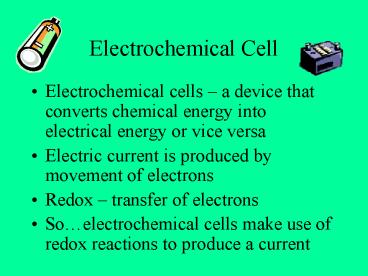Electrochemical Cell - PowerPoint PPT Presentation
1 / 17
Title:
Electrochemical Cell
Description:
Voltaic Cells a type of electrochemical cell that converts chemical energy to ... The first voltaic cell was invented by Alessandro Volta in 1800. ... – PowerPoint PPT presentation
Number of Views:198
Avg rating:3.0/5.0
Title: Electrochemical Cell
1
Electrochemical Cell
- Electrochemical cells a device that converts
chemical energy into electrical energy or vice
versa - Electric current is produced by movement of
electrons - Redox transfer of electrons
- Soelectrochemical cells make use of redox
reactions to produce a current
2
Voltaic Cells
- Voltaic Cells a type of electrochemical cell
that converts chemical energy to electrical
energy - The first voltaic cell was invented by Alessandro
Volta in 1800. - Voltaic cells take advantage of spontaneous (a
reaction that will happen naturally) redox
reactions
3
Voltaic Cell
- Requires two half-cells, a salt bridge, and a
wire to connect the two half-cells - Half-cell where one part of the redox occurs
(either the oxidation or the reduction) - Salt bridge allows ions to pass from 1
half-cell to the other without allowing the
solutions to mix completely
4
Voltaic Cells
- The half-cell that contains the oxidation is the
Anode (where the electrons are produced) - The half-cell that contains the reduction is the
Cathode (where the electrons are consumed)
5
6
Voltaic Cell
- Anode Oxidation occurs here
- Cathode Reduction occurs here
- e- flow from the anode to the cathode
- Anions (from the salt bridge) flow toward the
anode - Cations (from the salt bridge) flow toward the
cathode - Cathode will increase in mass
7
Electrical Potential
- Electrical Potential measure of a cells
ability to produce an electric current (in Volts) - Ecell Ered Eoxid
- We want a positive electrical potential
- Positive electrical potential spontaneous
reaction
8
Electrical Potential
- Example 1
- Cu e- ? Cu E 0.52 V
- Ag e- ? Ag E 0.80 V
- Ecell Ered Eoxid
- Ecell 0.80 0.52
- Ecell 0.28 V
- SoAg is reduced, Cu is oxidized
- Cu ? Cu e- Oxidized - Anode
- Ag e- ? Ag Reduced Cathode
- Ag Cu ? Ag Cu
9
Dry Cell
- Type of voltaic cell in which the electrolyte
(salt bridge) is a paste
10
Lead Storage Battery
- Battery group of connected cells
Car battery
11
Lead Storage
- Oxidation Pb(s) SO4-2(aq) ? PbSO4(s) 2e-
- Reduction
- PbO2 (s) 4 H (aq) SO4-2(aq) 2e- ?
PbSO4(s) 2H2O (l)
12
Lead Storage Batteries
- The redox reaction is spontaneous
- The battery recharges itself (the reverse
reaction). This reaction is not spontaneous, it
requires the alternator to make it go - Thereotically batteries would last forever
- Butsome lead sulfate will fall from the
electrodes (no longer making it able to recharge)
13
Fuel Cell
- Another type of voltaic cell
- Renewable electrodes (continuous energy supply)
- Electrodes are gases, not metals
- Earth Friendly
14
Fuel Cell
- Anode side2H2 gt 4H 4e-
- Cathode sideO2 4H 4e- gt 2H2O
- Net reaction2H2 O2 gt 2H2O
- Fuel Cell animation
15
Electrolytic Cells
- Use electrical energy to make chemical energy
- Used to make non-spontaneous reactions occur
- Need an outside power source to push electrons
- Uses only 1 solution
- Used for electroplating
16
Electrolytic Cell
17
Electroplating
- Anode Cathodeoxidation
reduction - Ag ? Ag e- Ag e- ? Ag
- Overall reaction Ag ? Ag e- ? Ag or
- Ag ? Ag































